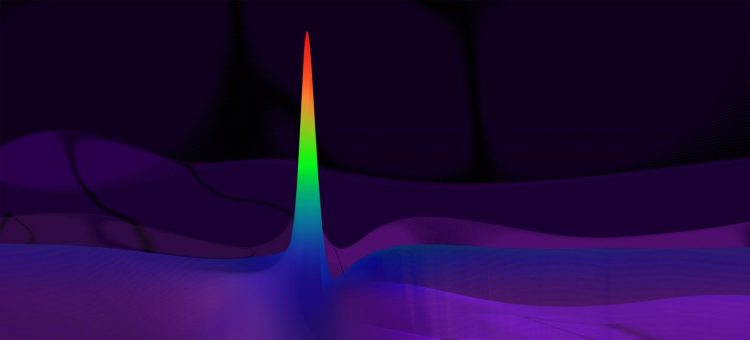Heading towards a tsunami of light

Ultra-intense light pulses, consisting of a single wave period, can be described as a tsunami of light. So far, such strong and short light pulses have never been observed. Now, researchers from Chalmers University of Technology and the University of Gothenburg, Sweden, propose a theoretical setup for creating the much-anticipated strong waves. The light pulses can be used to study interactions between matter and light in a new way. Credit: Yen Strandqvist/Illia Thiele/Chalmers University of Technology
“This source of radiation lets us look at reality through a new angle – it is like twisting a mirror and discovering something completely different,” says Illia Thiele, a theoretical physicist at Chalmers University of Technology.
Together with Dr Evangelos Siminos at the University of Gothenburg, and Tünde Fülöp, Professor of Physics at Chalmers, Illia Thiele now presents a theoretical method for creating the fastest possible single wave motion. This kind of radiation has never yet been observed in the universe or even the lab.
The radiation source is interesting for understanding the properties of different materials. Since it offers an ultra-fast switching of light matter interactions, it can be useful in material science, or sensor related research, for example. Moreover, it can be used as a driver for other types of radiation, and to push the limits of how short a light pulse could be.
“An ultra-intense pulse is like a great tsunami of light. The wave can pull an electron out of an atom, accelerating it to almost the speed of light, creating exotic quantum states. This is the fastest and strongest switch possible, and it paves the way for advances in fundamental research,” says Dr Illia Thiele.
The new pulses can be used to probe and control matter in unique ways. While other light pulses, with multiple wave periods, impose changes in the material properties gradually, pulses with a single strong wave period cause sudden and unexpected reactions.
Researchers worldwide have tried to create this source of radiation, since it is of high interest for the scientific communities within physics and material science.
“Now, we hope to be able to bring our theoretical setup to the lab. Our method could help close the existing gaps in the scientific landscape of light sources,” says Tünde Fülöp.
Read the scientific paper Electron beam driven generation of frequency-tunable isolated relativistic sub-cycle pulses in Physical Review Letters.
A more detailed explanation of the new method to create ultra-intense light pulses
The researchers propose a method for the generation of ultra-intense light pulses containing less than a single oscillation of the electromagnetic field. These so-called sub-cycle pulses can be used to probe and control matter in unique ways. Conventional methods can only produce sub-cycle pulses of limited field strength: above a certain threshold the amplifying medium would be ionized by the intense fields.
The researchers propose to use an electron beam in a plasma, which is not subject to a damage threshold, as an amplifying medium for a seed electromagnetic pulse. To ensure that energy is transferred from the electron beam to the pulse in such a way that a sub-cycle pulse is produced, the beam needs to be introduced at an appropriate phase of the oscillation of the electromagnetic field.
This can be achieved by using a mirror to reflect the seed pulse while the electron beam is being injected. This scenario leads to significant amplification of the seed pulse and the formation of an intense, isolated, sub-cycle pulse. Readily available terahertz seed pulses and electron bunches from laser-plasma accelerators could generate mid-infrared sub-cycle pulses with millijoule-level energies, which are highly desirable as probes of matter but not possible to produce with conventional sources.
###
For more information, contact:
Illia Thiele, Postdoctoral researcher, Department of Physics, Chalmers University of Technology, +46 76 607 82 79, illia.thiele@chalmers.se
Tünde Fülöp, Professor, Department of Physics, Chalmers University of Technology, +46 72 986 74 40, tunde.fulop@chalmers.se
Evangelos Siminos, Assistant Professor, Department of Physics, University of Gothenburg, +46 31 786 9161, evangelos.siminos@physics.gu.se
Media Contact
All latest news from the category: Physics and Astronomy
This area deals with the fundamental laws and building blocks of nature and how they interact, the properties and the behavior of matter, and research into space and time and their structures.
innovations-report provides in-depth reports and articles on subjects such as astrophysics, laser technologies, nuclear, quantum, particle and solid-state physics, nanotechnologies, planetary research and findings (Mars, Venus) and developments related to the Hubble Telescope.
Newest articles

Trotting robots reveal emergence of animal gait transitions
A four-legged robot trained with machine learning by EPFL researchers has learned to avoid falls by spontaneously switching between walking, trotting, and pronking – a milestone for roboticists as well…

Innovation promises to prevent power pole-top fires
Engineers in Australia have found a new way to make power-pole insulators resistant to fire and electrical sparking, promising to prevent dangerous pole-top fires and reduce blackouts. Pole-top fires pose…

Possible alternative to antibiotics produced by bacteria
Antibacterial substance from staphylococci discovered with new mechanism of action against natural competitors. Many bacteria produce substances to gain an advantage over competitors in their highly competitive natural environment. Researchers…





















